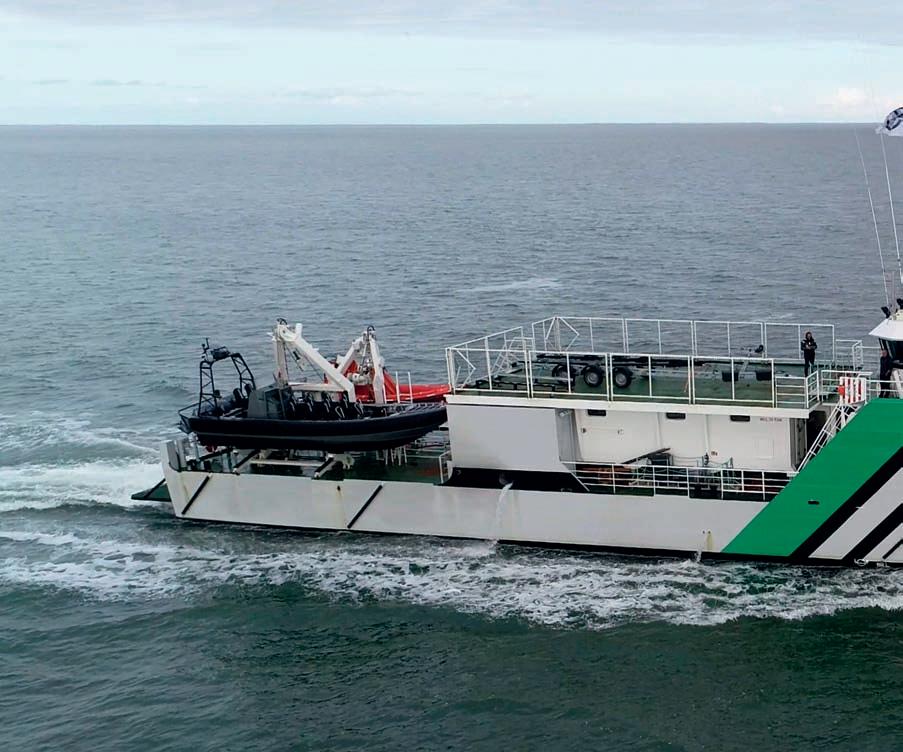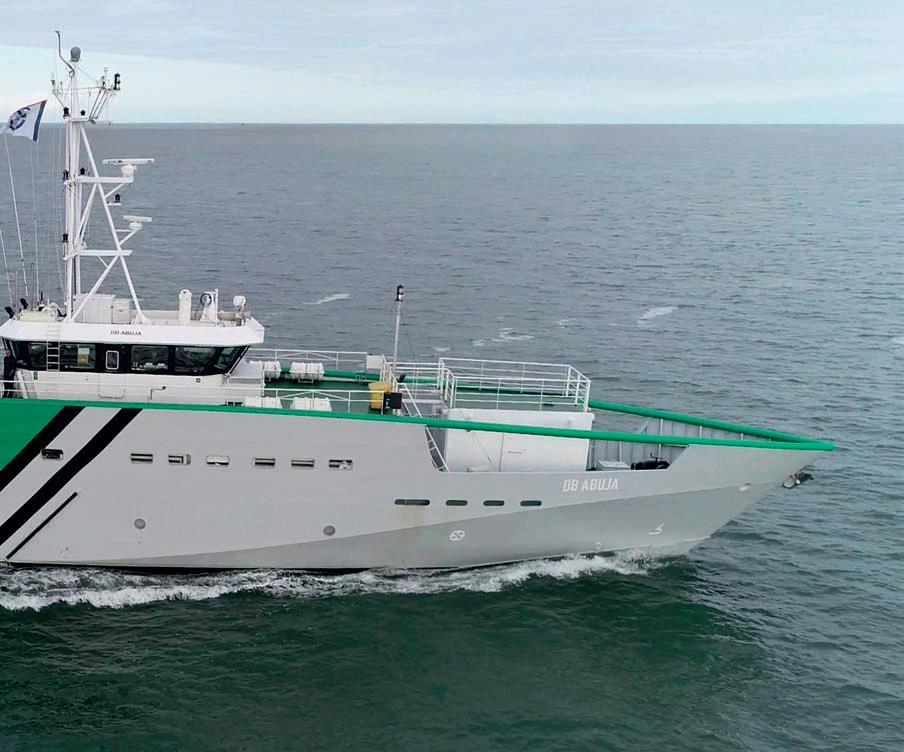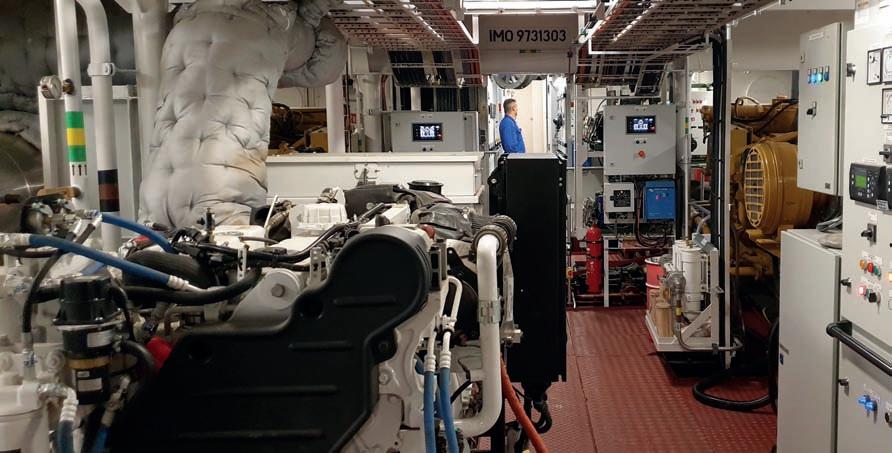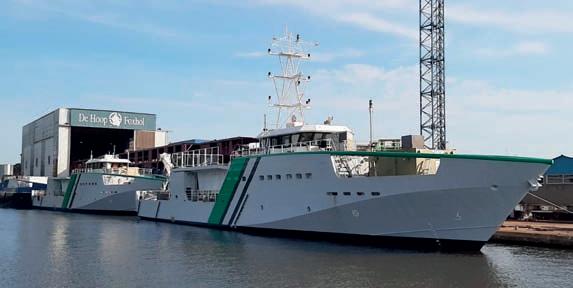
5 minute read
Dredger DB Abuja and DB Lagos: Two new Surveillance Vessels
Meet DB Abuja and DB Lagos
Two new Surveillance veSSelS DelivereD

shipyard de Hoop has recently celebrated its 130 th anniversary as a designer, engineer and builder of custom-built vessels. the origins of shipyard ‘de Hoop’ lie in lobith-tolkamer and date back to 1889. the shipyard’s facilities were partially destroyed by fire on several occasions and completely decimated during the second world war. after the war, a modern yard was built and the production of a large variety of advanced vessels began.
The delivery of The firsT of two Hybrid Multi-PurPose surveillance vessels To Blue ocTagon, an israeli securiTies solutions firm, has taken place in the eems harbour near delfzijl in the Netherlands.
All photos courtesy of de HooP sHiPyard.
DB Abuja at sea.
Having successfully arrived in Nigeria, shipyard de Hoop’s yard number 457, named db abuja, is now ready to perform her tasks, set by the Nigerian Maritime administration and safety agency (NiMasa), in Nigeria’s waterways. the second vessel for NiMasa – yard number 459, named db lagos, will arrive in Nigeria this month.
Hybrid Multi-Purpose Surveillance Vessels custom-designed by de Hoop to stringent environmental control, the hybrid dieselelectric powered 55m vessels are constructed primarily for low fuel consumption. the dP2-class vessels are developed for continuous operations 24 hours per day and are capable of remaining on station autonomously for at least 30 days. the vessels are powered by a unique hybrid diesel-direct/diesel-electric system. at low speed and during manoeuvring, only one diesel engine will be used to drive a generator, which produces power for two electric motors (driving the propeller shafts through the gearboxes) and a bow thruster. this provides fuel savings at low speed up to 12 knots and when in >>
Inside the hybrid multi-purpose surveillance vessel.

Hull under construction.


dynamic positioning mode. at high speed, both diesel engines will engage directly with the gearboxes to provide up to 4,700kw to the two fixed-pitch propellers (directly driven through the gearbox).
the multi-chine all-steel hull is optimised for fuel-efficient operations, in both transit and dP modes. the lightweight steel construction is built according to lloyd’s High-speed craft (Hsc) rules, whilst weight reductions have been achieved by using high tensile steel in combination with sophisticated construction techniques. the small entrance angles of the waterlines and the ‘long’ bowlines have the additional advantage of improved seagoing characteristics and thus reduced speed loss in more challenging sea states. even at a speed of 20 knots, the acceleration remains well within the comfort levels, while the extended and flared upper bowlines reduce the amount of green water and deck wetness. to further increase the seakeeping characteristics and to reduce the wave resistance, the stern is fitted with a hull-vane unit.
the superstructures and hulls provide integrated accommodation for up to 36 people on each vessel. with low noise and vibration levels, the vessels provide the
crew with high-standard accommodation. special detachable units, containing offices and storage spaces, are positioned on the fore and aft decks and connected to the vessel’s systems by means of receptacles and hose connections. on the aft deck unit, a basic type helicopter-landing platform is mounted, suitable for an aw109trekker or Grand New. on the aft deck to starboard side is a dedicated hydraulic pivoting a-frame davit, which is suitable for launching and retrieving an interceptor boat of maximum 5,000kg. to portside, a solasapproved hydraulic pivoting davit is fitted, to handle a Mob workboat with a total mass of maximum 3,000kg.
Deep Blue Project – Nigeria the maritime area of Nigeria, located at a strategic point of the Gulf of Guinea, is one of the busiest maritime areas in the world. the country’s coastline is some 853 kilometres long and its exclusive economic Zone covers more than 77,000m². this forces Nigeria to adopt pioneering and advanced security solutions for protecting their coastlines and seaborne assets. the goal of blue octagon, under the deep blue Project, is to assist the government of the republic of Nigeria, through NiMasa (a governmental body) to establish integrated National coastal surveillance and waterways protecting solutions, with command and control infrastructure, in the nation’s territorial waters. in these waters blue octagon will design and implement equipment, hi-tech systems and solutions, as well as training and operating courses.
NiMasa is responsible for regulating ‘shipping, maritime labour and coastal waters’ in Nigeria. it undertakes inspections and provides search-and-rescue services. once on-site, db abuja and db lagos have three main objectives under the training of blue octagon, namely the control of responsible use of the exclusive economic Zone of Nigeria, including assisting in cases of oil spills or other contamination; monitoring of safety at sea and various other services to NiMasa, including supervision on topics such as fishing and providing information to NiMasa regarding compliance with (inter)national legislation and obligations.
i. dehoop.net

De Hoop Shipyard from above.
DB Abuja and DB Lagos
Principal particulars Length, over all 55.00m Length, between perpendicular 49.95m Length, waterline (2.50m) 51.50m Beam, moulded 9.00m Depth, moulded 4.50m Draught, max 3.10m Speed, max 21kts Complement 4 crew in 2 twin-berth cabins 32 crew in 4 quadruple-berth cabins Total on board 36 crew members in 10 cabins
Propulsion plant Type of propulsion Hybrid Diesel-direct / Diesel-Electric Propulsion Main power 2 Caterpillar main engines / generator set combi Auxiliary power 1 Caterpillar 4.4 generator set Diesel propulsion mode 2x 2,350bkW at 1,800rpm (appr 21 kts) Electric propulsion mode 2x 350kW e-motors for (appr 12kts) aft main thrusters 1x 135kW e-motor for bow thruster
Classification
Hull
Tank capacities Fuel oil Fresh water Treated sewage Sewage Bilge water Coolant water Dirty oil Built to Lloyd’s High-Speed Craft (HSC) rules 100A1 SSC G4 MCH DP(AM) Patrol









